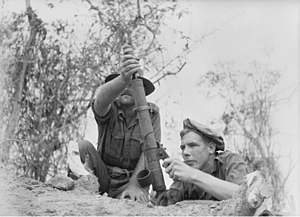Two-inch mortar
| Ordnance SBML two-inch mortar | |
|---|---|

Australian infantrymen using a 2-inch (51 mm) mortar in New Guinea in 1945 (AWM 094355)
|
|
| Type | Light mortar |
| Place of origin | United Kingdom |
| Service history | |
| Used by |
British Commonwealth armies Luxembourg |
| Wars | World War II, Korean War |
| Production history | |
| Designed | 1937 |
| Variants | Mark 8 "airborne" |
| Specifications | |
| Weight | 10 1⁄2 pounds (4.8 kg) |
| Length | 21 inches (53 cm) |
| Crew | Two |
|
|
|
| Shell | HE (high explosive): 2 lb 2 oz (0.96 kg). Smk (smoke): 2 pounds (910 g) Ill (illuminating): 1 lb 5 oz (600 g) |
| Calibre | 2 inch (50.8 mm) |
| Action | Trip |
| Elevation | 45-90° |
| Rate of fire | 8 rounds per minute |
| Effective firing range | 500 yards (460 m) |
The ordnance SBML two-inch mortar, or more commonly, the "two-inch mortar", was a British mortar issued to the British Army and the Commonwealth armies, that saw use during the Second World War and later.
It was more portable than larger mortars, and the two-inch (51mm) had greater range and firepower than rifle grenades.
The British Army had two types of mortars in service at the outbreak of the Second World War, one of which was a two-inch weapon for use with infantry platoons. The two-inch mortar had been developed during the 1930s after the British Army had inspected weapons of a similar calibre in service with other European countries, including the Spanish 50mm version. Although deemed unsuitable for the British Army as it stood, the Spanish mortar did serve as the starting point from which the Armament Research Department could begin development of its own weapon. In November 1937 ten examples of the new mortar were readied with 1,600 rounds each of high-explosive and smoke shells. The resulting trials confirmed the reliability and dependability of the weapon. The director of artillery ordered it to be placed in production in February 1938, only four months after the initial field trials, which meant that by 1939 some 500 of the weapons and their associated ammunition were already established in service as the Mk II, with crews trained in its use.
Over the duration of the war the two-inch mortar was developed into eight separate marks, from which also stemmed a number of other variations. Some were successful and others less so; one of the latter, the "Weston" version, was developed in 1944, but was found to be less than satisfactory when used on soft ground. This weapon had the advantage of being fitted with an automatic recocking feature of the firing mechanism, but despite this it was withdrawn from use.
The standard service version of the 2-inch (51 mm) mortar had a barrel length of 21 inches (530 mm) and could fire a high explosive bomb weighing 2.25 lb (1.02 kg) out to a range of 500 yards. With such a short barrel the normal firing method, where the bomb was dropped down the tube and a pin in the base of the barrel struck the detonator in the tail of the bomb, would not work so firing was by a small trigger mechanism at the breech. Originally the two-inch mortar was fitted with a large collimating sight with elevating and cross-level bubbles, but this was soon dropped as unnecessary for front-line use. It was replaced with a simple white line painted up the length of the barrel. The firer only had to line this up in the direction of the target and fire a number of bombs for effect. While this method of operation appeared rather haphazard, it worked well and the practice continued long after the war. The mortar evolved in other directions too, with the original large base plate being replaced by a simple curved model, to give it a combat weight of 10.25 lb (4.65 kg). Due to its small size, and for simplicity, the mortar had no forward strut or bipod that most larger designs needed. The barrel was held at the correct angle by one soldier while the other loaded and fired the round. It could achieve a firing rate of some eight rounds per minute. The bombs were cylindrical with a perforated four-finned tail. For the HE projectiles an impact fuze was fitted in the nose of the bomb. The illuminating round weighed 1 lb (0.45 kg) and the smoke round weighed 2.25 lb (1.02 kg). A whole range of other ammunition was also developed, including a specialised bomb that cast a lightweight explosive-filled net over minefields which could be detonated, clearing a path.
...
Wikipedia
